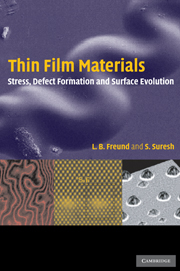Book contents
- Frontmatter
- Contents
- Preface
- 1 Introduction and Overview
- 2 Film stress and substrate curvature
- 3 Stress in anisotropic and patterned films
- 4 Delamination and fracture
- 5 Film buckling, bulging and peeling
- 6 Dislocation formation in epitaxial systems
- 7 Dislocation interactions and strain relaxation
- 8 Equilibrium and stability of surfaces
- 9 The role of stress in mass transport
- References
- Author index
- Subject index
2 - Film stress and substrate curvature
Published online by Cambridge University Press: 06 July 2010
- Frontmatter
- Contents
- Preface
- 1 Introduction and Overview
- 2 Film stress and substrate curvature
- 3 Stress in anisotropic and patterned films
- 4 Delamination and fracture
- 5 Film buckling, bulging and peeling
- 6 Dislocation formation in epitaxial systems
- 7 Dislocation interactions and strain relaxation
- 8 Equilibrium and stability of surfaces
- 9 The role of stress in mass transport
- References
- Author index
- Subject index
Summary
The existence of residual stress in films deposited on substrates and the effects of such stress on delamination and cracking were recognized as early as the nineteenth century. For example, an antimony film deposited on a substrate was found to be prone to cracking as a result of vibration or local application of heat (Gore 1858, Gore 1862). Gore ascribed the bending of the deposited layers to the development of ‘unequal states of cohesive tension’ through the thickness of the deposit. The Earl of Rosse (circa 1865, cited in Nature, Aug. 20, 1908, p. 366) attempted to make flat mirrors by chemically coating glass with silver and then electroplating with copper. It was noted that the contraction of copper film caused it to be detached from the glass. Stoney (1909) found that copper electrodeposited as a protective layer on silver films in searchlight reflectors easily ‘peeled off’ when the thickness of the copper layer was in excess of 10 µm.
Stoney (1909) made the observations that a metal film deposited on a thick substrate was in a state of tension or compression when no external loads were applied to the system and that it would consequently strain the substrate so as to bend it. He suggested a simple analysis to relate the stress in the film to the amount of bending in the substrate.
- Type
- Chapter
- Information
- Thin Film MaterialsStress, Defect Formation and Surface Evolution, pp. 86 - 153Publisher: Cambridge University PressPrint publication year: 2004
- 3
- Cited by



